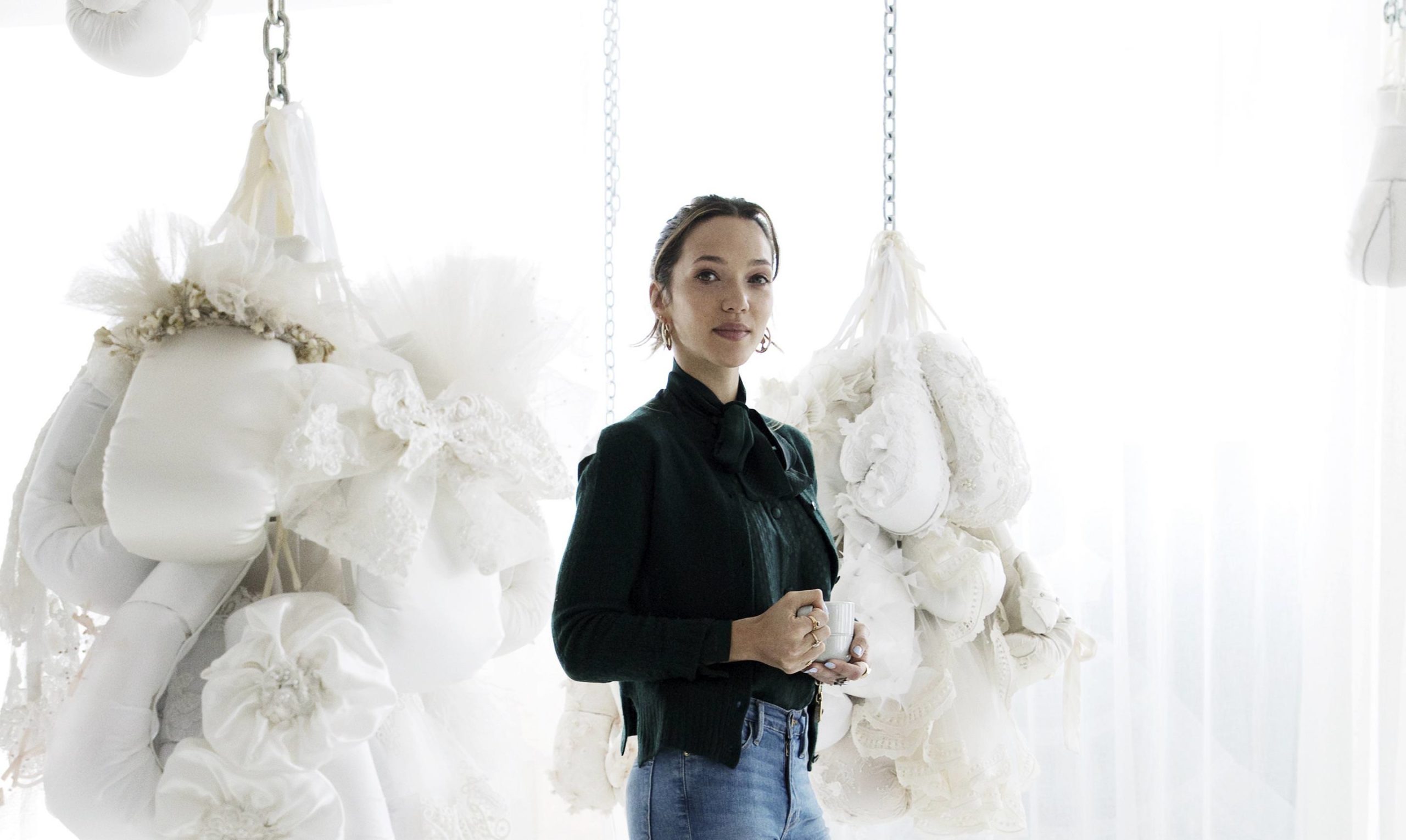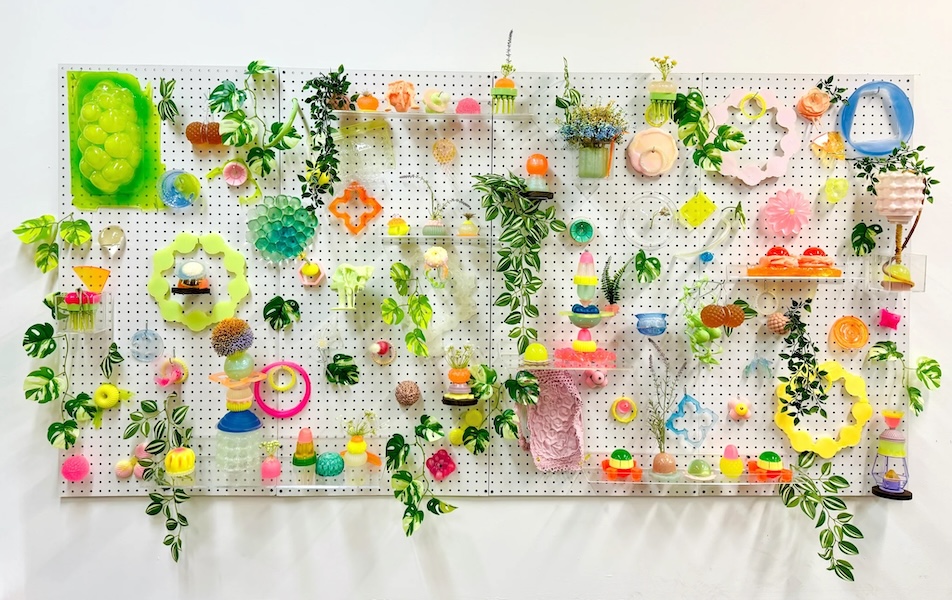For the artist Zoe Buckman, art has always been married to activism. In her work, she strives to make women’s issues society’s issues. Early this year, her public work CHAMP went up at The Standard, Los Angeles. Standing 43 feet tall, it’s a white neon uterus with boxing gloves for ovaries (presented by Art Production Fund and Alice + Olivia). The piece previously garnered a great deal of attention at PULSE Miami Beach art fair in December of 2016, just weeks after the presidential election. The neon (this version in bright pink) blew up everyone’s Instagram feed. Originally, Buckman had thought it would serve as a celebratory symbol after Hillary Clinton won the presidency—alas, it became a bittersweet example of the fight ahead of us.
Buckman grew up in an activist family. Her mother was a member of the communist party and worked in community theater. Buckman was brought up to believe that whatever you choose to do, it needs to be in some way socially engaged. You must find a way to give back to society and the world. She always saw art as a vehicle for speaking out about feminist issues.
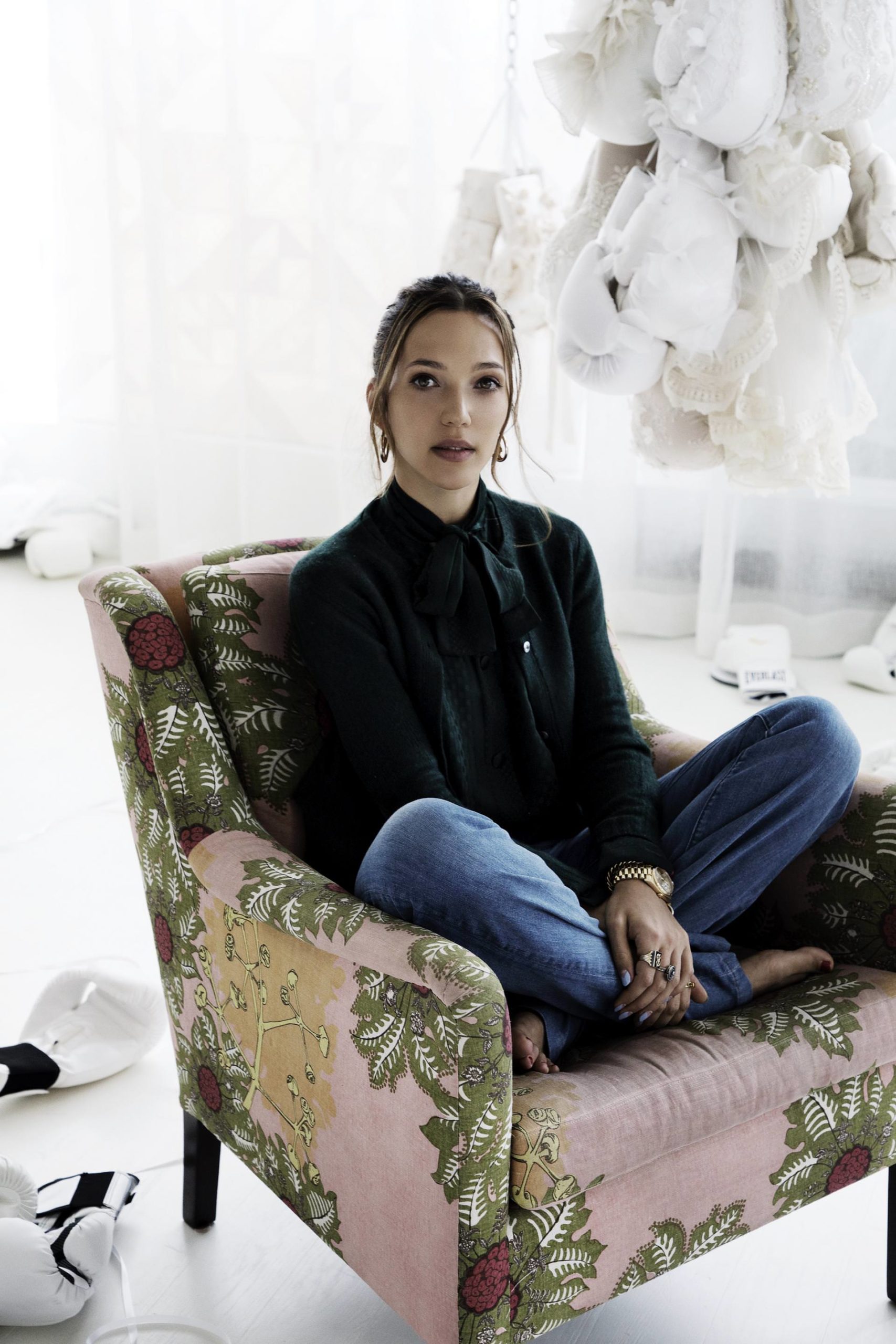
Portrait by Steve Benisty.
She has done so through work that deals with childbirth and motherhood (Present Life in 2015), sexism (Every Curve in 2016), reproductive health (Mostly It’s Just Uncomfortable in 2016), and empowerment in her most recent solo show, “Let Her Rave,” which was on view at Gavlak Gallery March 3–April 7 this year in Los Angeles.
But Buckman has long been interested in going beyond the gallery walls to present more public work. CHAMP, which is on view for a year, follows a number of other smaller public works—We Hold These Truths to Be Self-Evident (2017) with Natalie Frank at the New York Live Arts Ford Foundation Live Gallery; and Grab ’Em by the Ballots (2016), a For Freedoms billboard in Harrisburg, Pennsylvania. Buckman will collaborate with For Freedoms again the fall to create another billboard for its 50 State Initiative (now raising funds on Kickstarter).
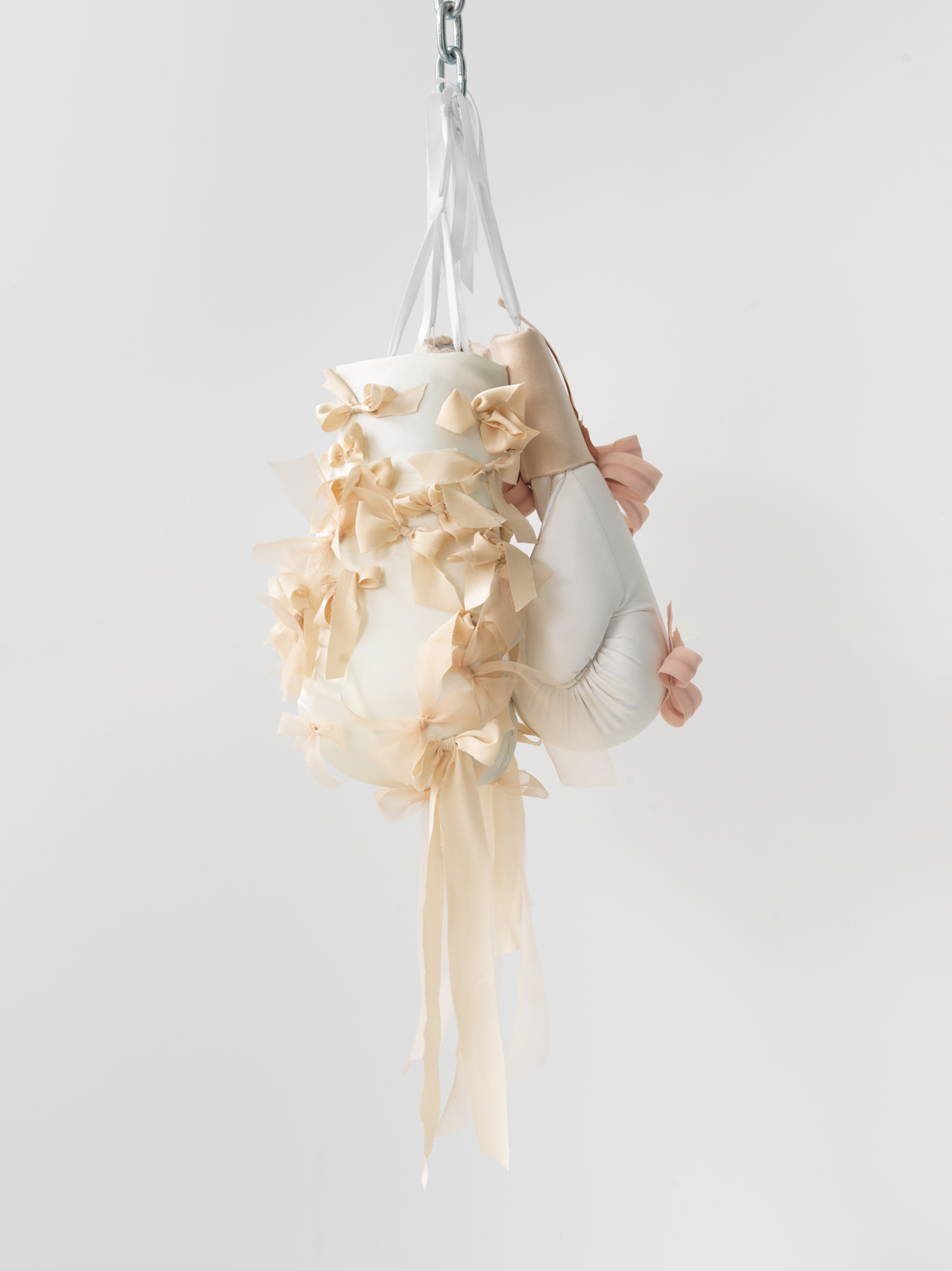
Zoe Buckman
Morning Rose
2017
3 boxing gloves, vintage wedding dresses, chain
18 x 12 x 12 inches
Courtesy of the artist and Gavlak Gallery
Whitewall visited Buckman in her new Brooklyn studio, right around the time that CHAMP was opening to the public. We spoke with her about bringing more men into the feminist movement, taking power into her own hands, and vulnerability.
WHITEWALL: In late February, your public work CHAMP debuted in front of The Standard, Los Angeles, supported by Art Production Fund and Alice + Olivia. It’s going to be up for a year. What’s it like to have such major public work go on view?
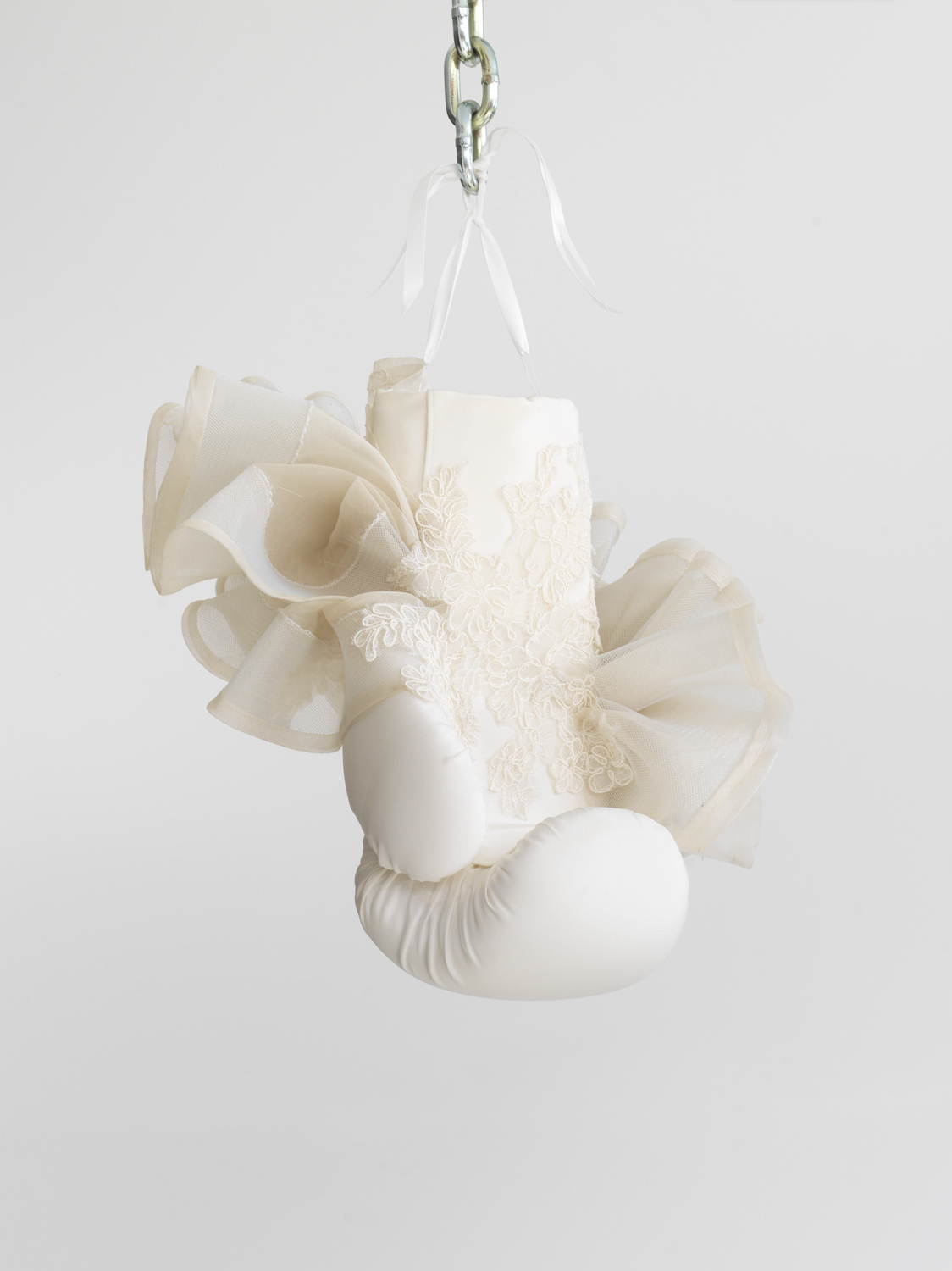
Zoe Buckman
Dirty Ruffle
2017
1 boxing glove, vintage wedding dresses, and chain
11 x 7 x 5 inches
Courtesy of the artist and Gavlak Gallery
ZOE BUCKMAN: I’m so excited. It’s the first time I’ve had anything in the public realm that takes up as much space and has as much presence and will be up for as long. The billboard I did with Natalie [Frank, We Hold These Truths to Be Self-Evident (2017)], because it was in the lobby of a theater, didn’t gets in the face of the general public in the same way. Then, the billboard in Philadelphia with For Freedoms [Grab ’Em by the Ballots (2016)], I think that was up for just a week. So this feels like a totally new opportunity and experience for me.
I think one of the things I’m so excited about with this piece is the way in which it will have the opportunity for equal visibility between the bus drivers on Sunset Strip, the Hollywood execs who work and have meetings there, from the men and women who work in the hotel to the guests in the hotel. I love the really nondiscriminatory nature of public art versus gallery shows.
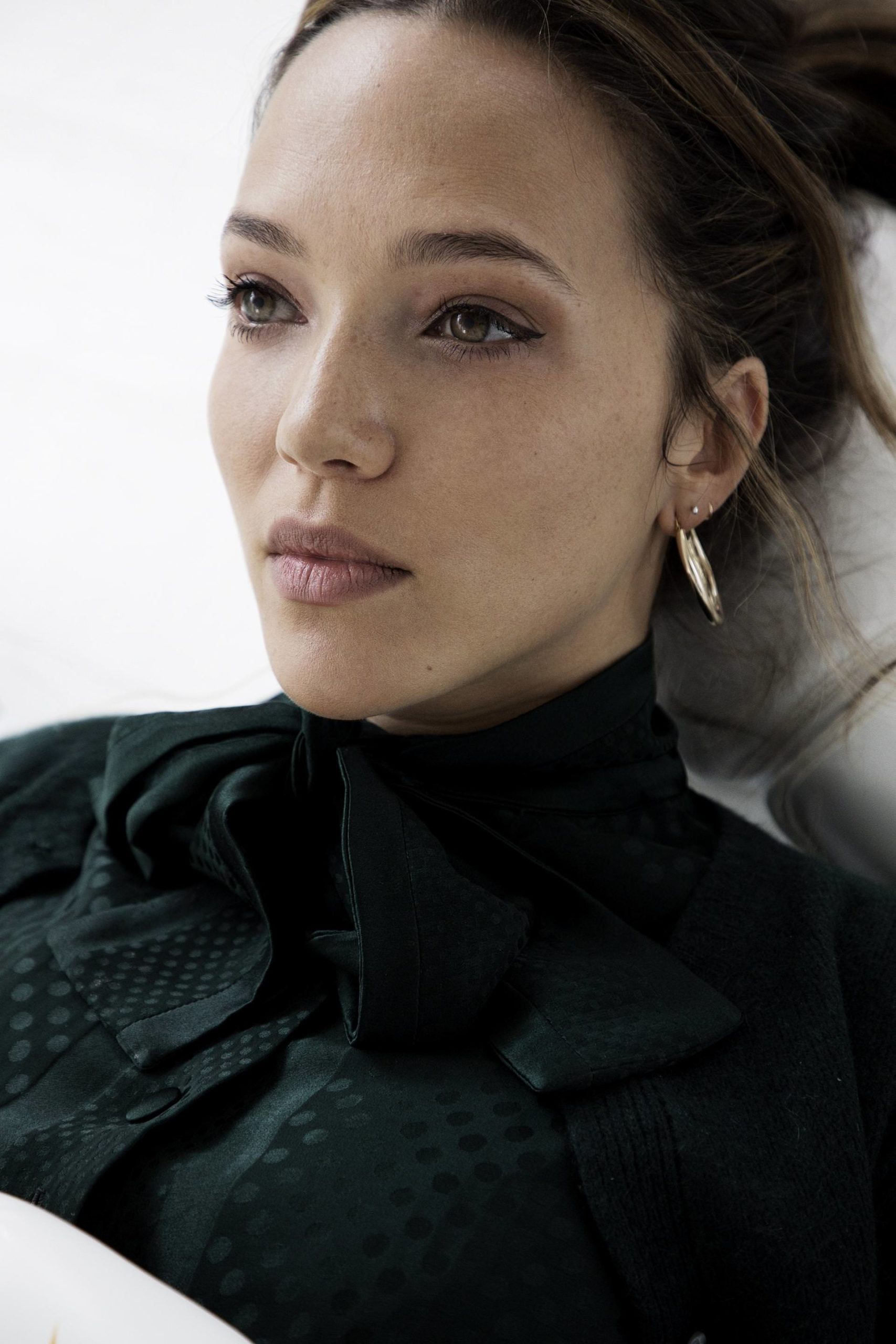
Portrait by Steve Benisty.
WW: Speaking of gallery shows, you had one open at the same time as the unveiling of CHAMP, at Gavlak in L.A.
ZB: Yes! What a blessing.
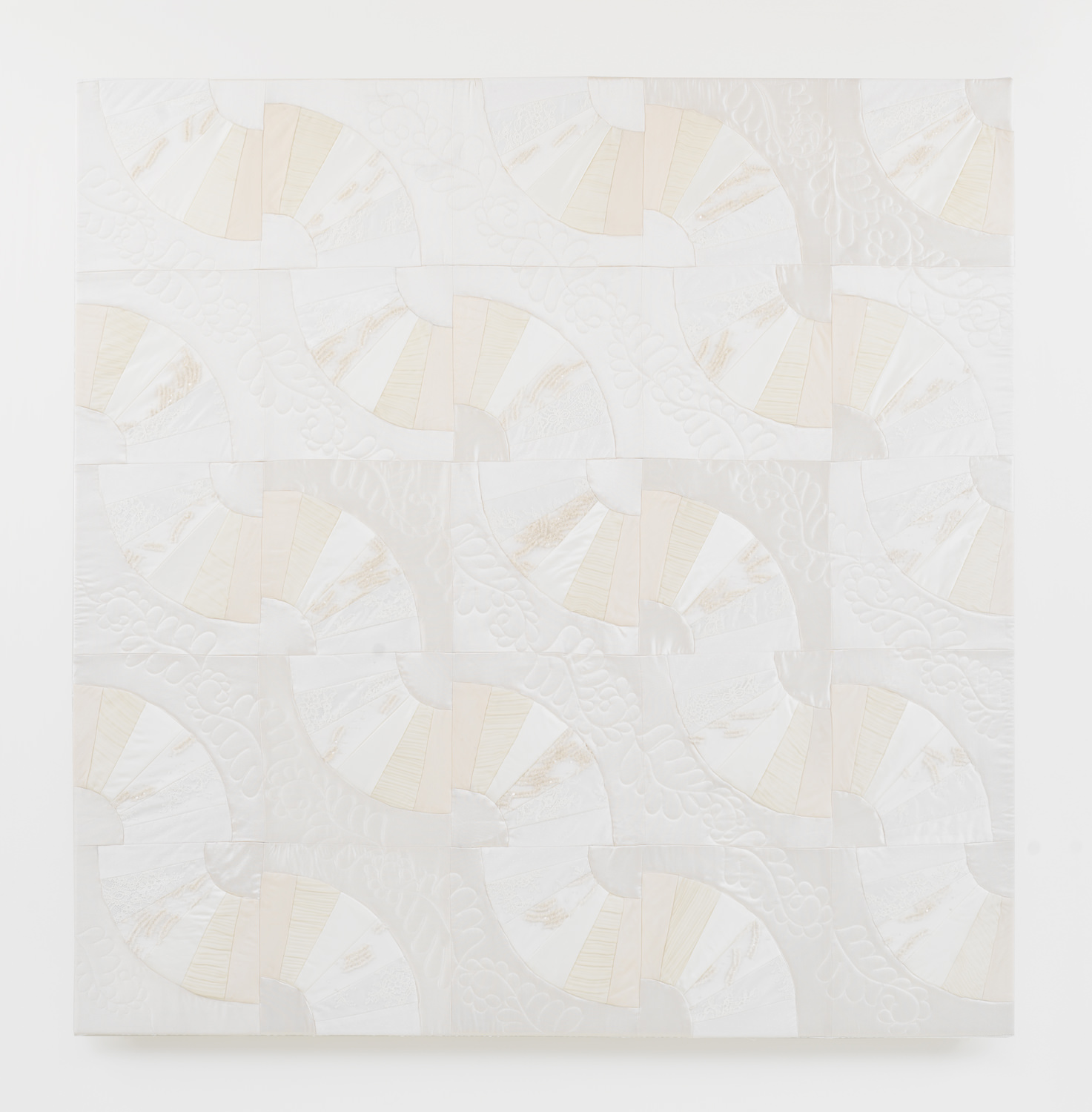
Zoe Buckman
Shade to Shade
2017
Quilted vintage wedding dresses
62 x 62 inches
Courtesy of the artist and Gavlak Gallery
WW: You previously showed CHAMP during PULSE Miami Beach in December of 2016. There, it was pink. In L.A., it’s white. Can you tell us about that color choice?
ZB: My wish for feminism is that we’ll just grow ever more intersectional and inclusive and speak to all genders and all ethnicities and backgrounds. And we’ll create a space for equal agencies for all women and that we’ll draw men and trans men and trans women into these vital conversations. If I can contribute to that in any sort of way, I want to make sure I do my bit in that.
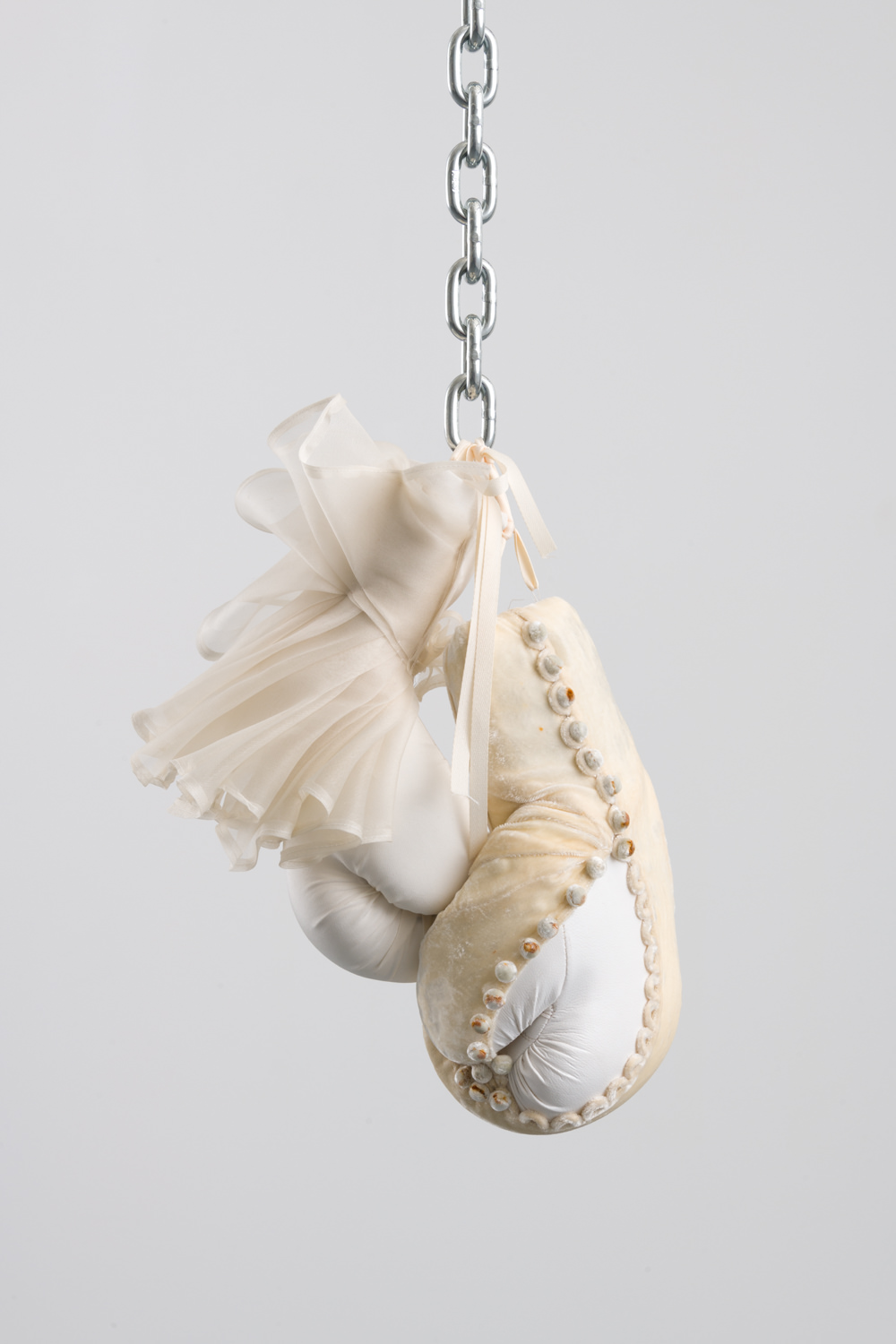
Zoe Buckman
Poisonous Tongue
2018
2 boxing gloves, vintage wedding dresses, chain
15 x 9 x 6 inches
Courtesy of the artist and Gavlak Gallery
The decision to go from pink to white was because I don’t want to give men or women the opportunity to write off this piece as a piece that just speaks to women, by women, for women. I want to make women’s issues society’s issues. It’s just a fact that pink is associated with femininity and women, so the white is a strategic decision to make it a more universal piece.
WW: Was there anything from that project that surprised you in terms of considerations for a public work?
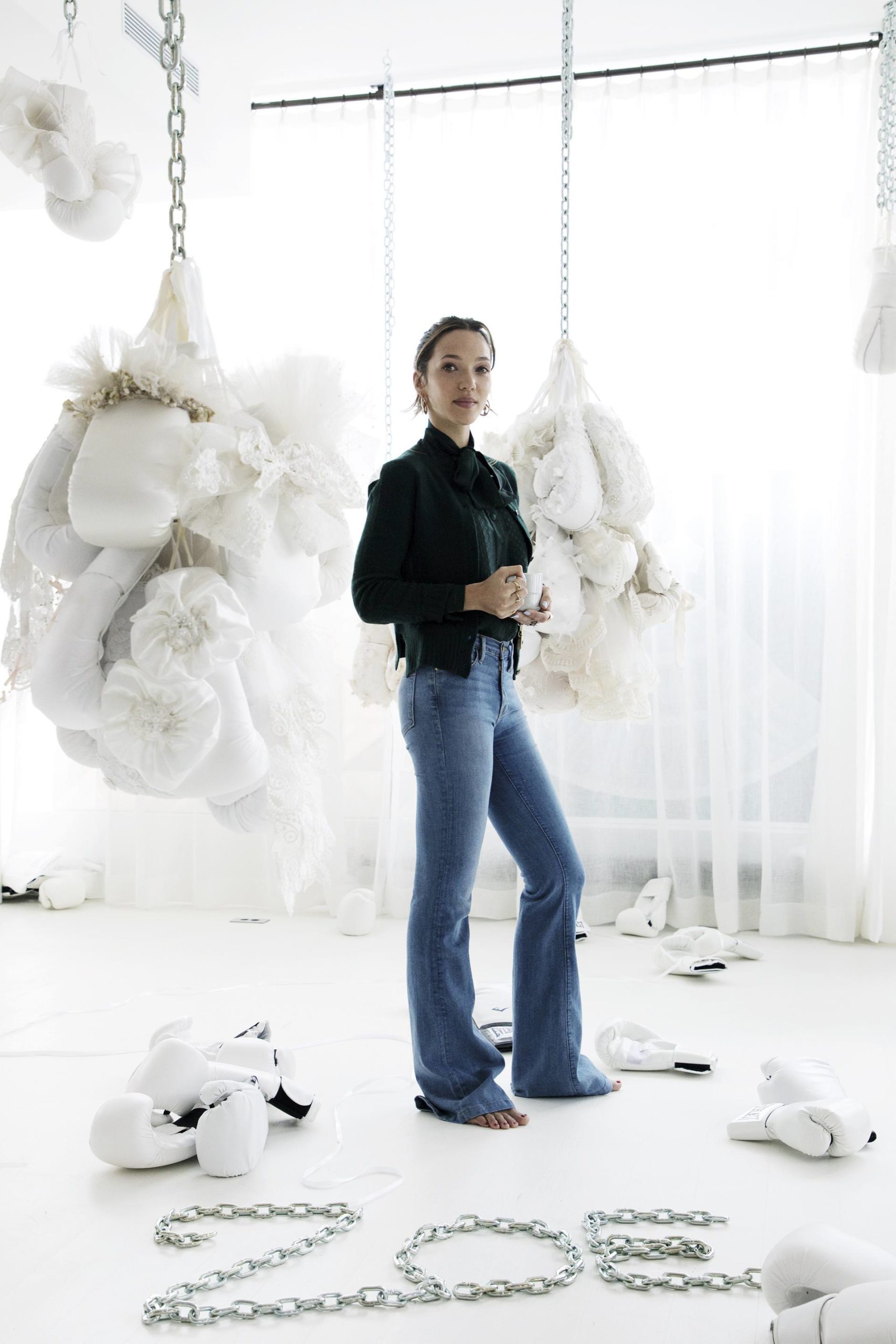
Portrait by Steve Benisty.
ZB: Yeah, I didn’t realize just how much sign-off and permitting and red tape there was to get through. That’s why working with Casey [Fremont at Public Art Fund] has been so incredible. She knows this stuff back to front and she has the ability, through her experience, to see all angles and be prepared for a myriad of challenges that I couldn’t even conceive of.
I had never really heard of a base plate for a piece of art. They drilled into the pavement; they already created the base plate underground that will support the structure. I’ve never even thought of the word “structure” in regard to my artwork.
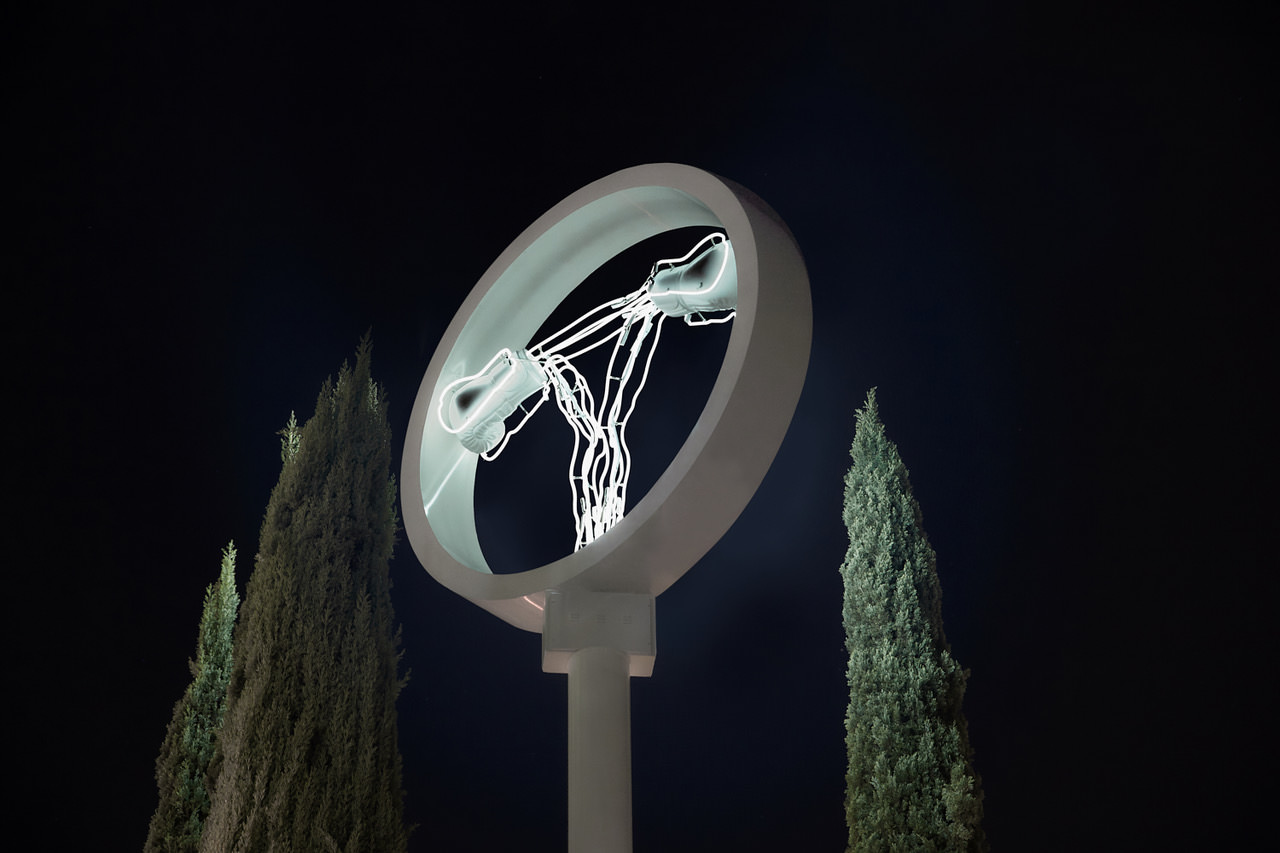
Zoe Buckman
Champ
Photo by Veli-Matti Hoikka
Courtesy of Art Production
Presented by Art Production Fund at The Standard, Hollywood with support by alice + olivia by Stacey Bendet
WW: Tell me about the show at Gavlak, “Let Her Rave.”
ZB: It’s the first time I’m showing “Let Her Rave” as a solo show. I’ve shown little bits of it before in group shows, but I’ve never done what I intended, which was to create a solo experience of that work.
The title, “Let Her Rave,” is taken from a line in a Keats poem. It’s my favorite poem of all time—Ode on Melancholy. He says, “If thy mistress some rich anger shows, / emprison her soft hand, and let her rave.” Even though I have great appreciation for him as a writer and his art, that line in that poem has grown increasingly problematic to me.
So I started to make work that was about social constructs that keep women hemmed in or held back, shackled by ideas of chastity and perfection and purity. I started to acquire these used wedding dresses, and I would cut them up and pin them to boxing gloves. They’re all very tightly and perfectly sewn together onto the gloves, and then I assembled them with ribbons on chains. They’re very much inspired by the heavy bags in a boxing gym or the speed bags in a boxing gym. I like that kind of tension between the really resilient, masculine, chunky chains, and these very intricate, tactile, pretty gloves.
My intention with this work is, when you first encounter a cluster, you take in that it is sumptuous and pretty and maybe you want to touch it, but the closer you get and the more time you spend, you get this feeling of imprisonment. And that speaks back to the line in the poem.
WW: And what about the quilted works?
ZB: There will be these four quilted pieces. They are mainly geometric shapes all sewn together—again, all used wedding dresses that are speaking to this collective experience of women. If you look at each dress, it does tell its own story, but together all of these different stories are supporting each other in this general picture of something that is strong but also something we associate with nurturing and protection. And you think about quilts and quilting and how women have been handing down over centuries those skills.
There’s also this dark-red neon that says, “Let her rave.” Neon is associated with celebration. It’s bright and can speak to ideas of a rave or a party. But the fact that this neon is dark red draws your attention to the idea of let her rave, the idea of being given permission to do something opposed to just doing it. Since it’s dark red, it’s dim. The reason it’s dimmed is because we shouldn’t be given permission. I’ve been meaning to work with that dark red for a long time and that felt like the right piece.
WW: Is that color difficult to achieve?
ZB: Yeah, it’s super-rare. The tubing is actually painted dark blue and it’s illuminated with red neon, so it’s kind of this frosty, desaturated color and it’s very rarely used.
WW: You’ve worked with neon before and vintage lingerie as well. How did you come up with the idea to work with wedding dresses?
ZB: I feel like the lingerie led itself to my working with wedding dresses. But to be completely honest, this work was something I was making during separating from my marriage and getting divorced. This work is very much about my disillusionment with the idea of marriage—not just speaking to how patriarchy is designed to mold women into a certain idea, but how the patriarchy is so ingrained that we are complicit in our own molding into these ideas. For many women, this is something we just take on.
Wedding dresses are so loaded. It’s not just three buttons down the back; it’s fifty buttons. There’s boning and things to keep this in and push this up. It’s stressful, and it has to be perfect.
WW: Did you use yours?
ZB: That piece there is my veil [points to a cluster of gloves hanging from the ceiling]. The rest of the veil has gone into two quilts, and the dress is slumped in the corner over there. I will use it, but I think I might want to use it in some sort of performance or some video or something.
WW: Do you find that women react a certain way to this work?
ZB: Yeah, I do. I’ve even had women donate their discarded dresses; sometimes it’s women I know and sometimes they hit me up on Instagram. They’ll be like, “I’m on my third marriage. Do you want my first two dresses?” I’m like, “I’ll take it.”
WW: CHAMP got such a huge reaction in Miami in 2016. And has remained a lightning rod for the feminist movement. What has that been like for you?
ZB: It’s really surprised me. I feel like I made the piece for myself, actually. Then, when I put together the first iteration on my studio wall, I really liked where it was going and I wanted to share it. So I started showing it and I was completely surprised and deeply moved by the responses that started coming in. It seems to reach women all across the board, speaking to so many different struggles that women face. That has been really gratifying.
WW: Your show “Present Life” in 2015 included sculptural work that referenced the placenta and even featured your actual plasticized placenta. As women, we’re reminded at least every month about these parts of our bodies, so it’s not as shocking to see. Personally, we found it emboldening and empowering. Others aren’t as comfortable. Do you ever feel vulnerable using these kinds of references, presenting the female body as it is?
ZB: I do still feel vulnerable. I don’t feel vulnerable when I think about the piece that I want to make or when I create it, but I do right before I show it. Right before my solo show “Present Life,” I was suddenly struck by the fact that I was about to literally put a piece of me in the gallery for people to pooh-pooh or laugh at. I felt really vulnerable. Once you’ve done that, it does make it easier. I feel like that was my first proper solo show so to start off with being like, “This is me!”
WW: Even “Mostly It’s Just Uncomfortable,” your series of gynecological chairs and tools that you powder-coated to make more playful, felt like a revelation. Like finally, someone is making work about what every woman has to go through.
ZB: Totally. It’s just staggering to me how for so many of us, myself included, the minute I’m in a doctor’s office, so much of my strength and confidence and my agency just goes out the window.
I think one of the things that we all know as women—and now the rest of society is starting to realize—is that all women have suffered some kind of sexual assault or sexual harassment. All women have gone through something that was not entirely consensual or entirely appropriate. And if you make it to an adult woman and you haven’t been raped, you’ve had a good life. That’s how fucking rife it is.
WW: How did boxing become something you wanted to bring into the studio?
ZB: I felt that that had to naturally come into the studio. I first started boxing in 2015 and it was when things were starting to rev up. Trump and Clinton hadn’t been announced as candidates, but things were starting to circulate about rape and abortion. There was all this talk about choice and our bodies, which always leads into if the mother is raped . . . I was feeling that there was a war on women, that there is a war on women that hasn’t gone away. I take these comments personally, so I was feeling very under threat.
Boxing was a way of me working through some of my aggression and frustration, but it was also an exercise in which I could learn to hold my own space and defend myself and take away space from other people—which I found really difficult. In the first year I was training, every time I would land a punch onto my coach, I would be like, “Oh, my gosh, sorry!”
Boxing was amazing on a personal level. I was already making Mostly It’s Just Uncomfortable, about these political issues, and then I was going and working it out on a personal level in the boxing gym. I just felt like that naturally needed to come into the work. That’s what the work was missing. I was in gyno-world, which was very female-centric, and it needed to have some masculine iconography in it.


